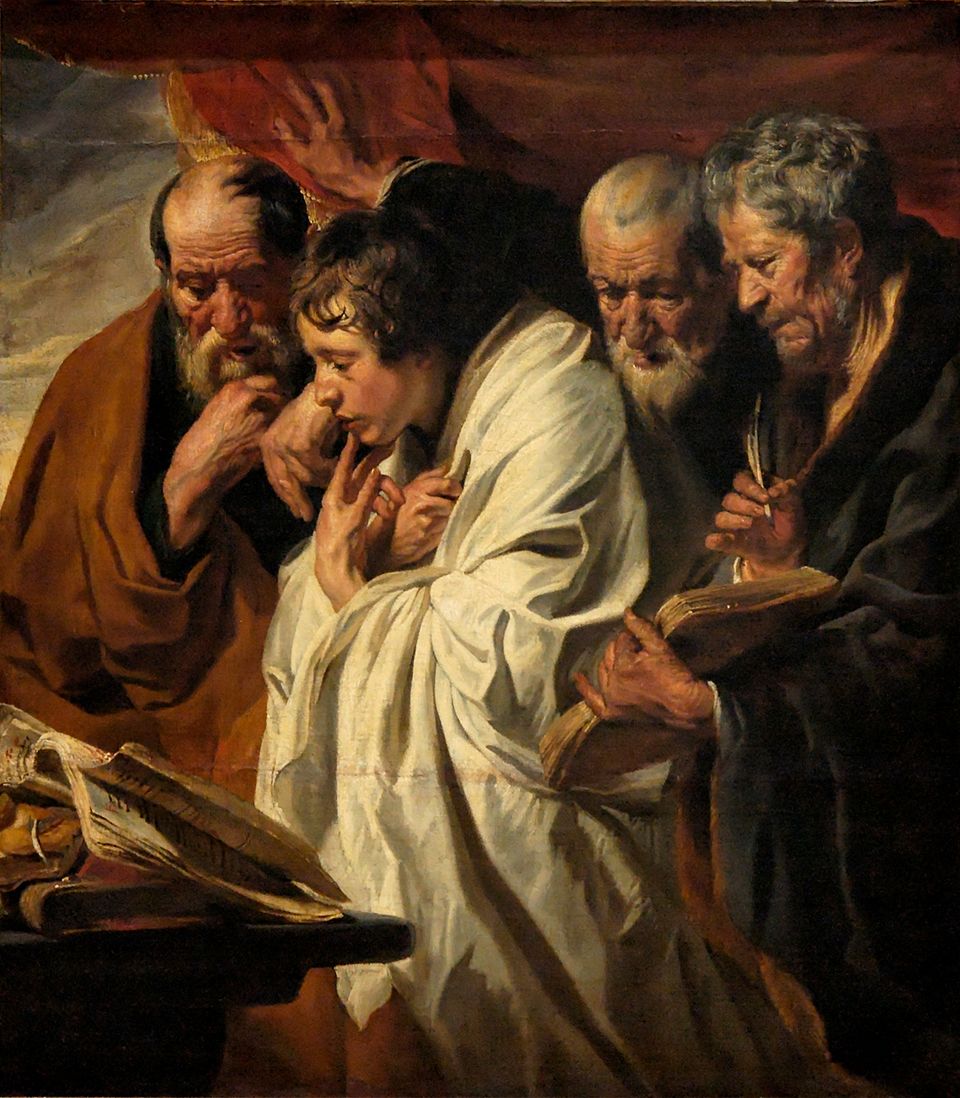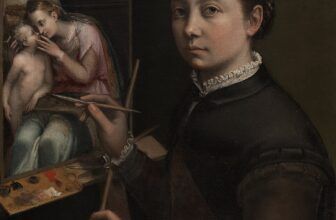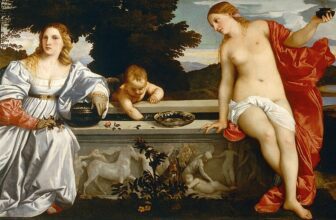
Meaning of The Four Evangelists Painting
In the grand halls of Western art, few painters possess the raw emotional intensity and masterful storytelling ability of Jacob Jordaens, the celebrated Flemish Baroque painter. While Jordaens is perhaps better known for his robust mythological and genre scenes, his religious works stand as powerful visual sermons, embodying both spiritual gravity and painterly brilliance. Among these is his remarkable painting The Four Evangelists, a deeply symbolic and spiritually charged masterpiece that continues to captivate scholars, theologians, and art lovers alike.
In this post, we embark on a comprehensive journey to explore The Four Evangelists by Jacob Jordaens, delving into its historical creation, artistic techniques, layered meanings, and present-day relevance. From the brushstrokes on the canvas to the timeless truths inscribed in its symbolism, this painting is more than an artwork; it is a visual meditation on divine revelation and human inspiration.
Who Was Jacob Jordaens?
Born in Antwerp in 1593, Jacob Jordaens was one of the towering figures of the Flemish Baroque movement, alongside Peter Paul Rubens and Anthony van Dyck. Although he never traveled to Italy, unlike many of his contemporaries, Jordaens absorbed the grandeur of the Italian Renaissance through his own Flemish roots, particularly the influence of Rubens, who was both his mentor and rival.
Known for his vibrant palette, muscular figures, and expressive faces, Jordaens brought a grounded humanity to both secular and religious subjects. He worked during a time when the Catholic Counter-Reformation sought to use visual art as a persuasive medium of faith, and his works often reflect this religious zeal and theatrical energy.
The Painting: The Four Evangelists
The Four Evangelists is believed to have been painted between 1625 and 1630, during the height of Jordaens’ artistic maturity. While several versions and interpretations of the Evangelists existed in art history, Jordaens’ rendition stands out for its psychological depth and rich symbolism.
The painting features the four Evangelists, Matthew, Mark, Luke, and John, authors of the canonical Gospels in the New Testament. Each is depicted in the act of writing or contemplating their Gospel, accompanied by their traditional symbolic companions: an angel for Matthew, a lion for Mark, an ox for Luke, and an eagle for John. These figures are not merely decorative but are integral to the composition’s spiritual and thematic coherence.
Today, The Four Evangelists by Jordaens resides in the Musée des Beaux-Arts de Nantes, France, where it is displayed as part of the museum’s rich collection of 17th-century Flemish art.
Composition and Artistic Style
From a purely artistic standpoint, The Four Evangelists exemplifies the Baroque aesthetic at its finest. The composition is both dynamic and balanced, with each Evangelist commanding his own space while also contributing to a unified tableau. The figures are robust, with powerful anatomical modeling that reflects Jordaens’ command of the human form.
The setting is dimly lit, yet the light is used dramatically, illuminating the faces and hands of the Evangelists to focus attention on their divine task. The use of chiaroscuro (light and shadow) creates a sense of spiritual revelation as if the divine Word is literally casting light upon these men. The palette is rich and earthy, with deep reds, browns, and golden hues, which lend the scene both gravitas and warmth.
Jordaens’ brushwork is vigorous and confident. The textures of fabric, fur, and flesh are rendered with tactile realism. There is a certain theatricality in the gestures and expressions of the Evangelists, typical of Baroque art, yet it never feels contrived. Instead, it underscores the profound emotional and spiritual engagement of the figures with the divine message they are recording.
What Is Happening in the Painting?
At first glance, the painting appears to be a portrait of four scholars immersed in their work. But a closer inspection reveals that something more extraordinary is occurring. Each Evangelist is not simply writing; they are divinely inspired, channeling sacred revelation into human words.
Matthew appears to be listening to an angel who whispers guidance into his ear, his quill poised mid-air. Mark gazes pensively, his lion crouched beside him, symbolizing both vigilance and strength. Luke, often thought to be a physician, is portrayed with an ox, a symbol of sacrifice and service, staring upward as though awaiting inspiration. John, the most mystical of the Evangelists, looks toward an eagle that soars above him, representing spiritual elevation and divine insight.
The companions are not merely symbolic identifiers, they embody the spiritual character of each Gospel. The lion for Mark suggests the bold proclamation of Christ’s power. The ox for Luke emphasizes the theme of Christ’s sacrificial mission. The angel for Matthew reflects the Gospel’s focus on Christ’s humanity and fulfillment of Jewish prophecy. The eagle for John represents the Gospel’s soaring theological perspective, which begins not with earthly events but with the cosmic declaration: “In the beginning was the Word.”
Each figure is caught in a moment of divine illumination. Jordaens masterfully captures the tension between earthly labor and heavenly inspiration, a central theme in Christian theology.
Symbolism and Deeper Meaning
The painting is drenched in symbolic meaning. Let us explore the key elements:
1. The Evangelists as Instruments of the Divine
The Evangelists are not portrayed as heroic individuals but as vessels of a greater power. Their intense focus, meditative expressions, and communion with their symbolic beasts suggest that they are being used by the Holy Spirit to record divine truth. This reflects the doctrine of biblical inspiration, that Scripture, though written by human hands, is ultimately the Word of God.
2. The Four Creatures
The four creatures accompanying each Evangelist derive from the Book of Ezekiel and Revelation, where the prophet describes four living beings surrounding the throne of God, each with a different face: man, lion, ox, and eagle. Early Christian theologians, especially St. Jerome, associated each of these with one of the Gospels, establishing a tradition that artists like Jordaens followed.
These creatures are not passive symbols; they are animate, involved. The angel is speaking to Matthew. The lion and ox are alert, as if sensing the weight of the moment. The eagle’s eyes are raised to the heavens. They reinforce the notion that these writings transcend human origin.
3. Books and Scrolls
The presence of books and scrolls not only emphasizes the literate and scholarly nature of the Evangelists but also serves as a metaphor for divine wisdom made accessible to humanity. The written word becomes the bridge between heaven and earth.
4. Light and Shadow
Jordaens’ use of light is almost theological in nature. The light does not come from any natural source; rather, it seems to emanate from within the scene itself, perhaps symbolizing the divine presence or the Holy Spirit. The shadows, by contrast, represent the mystery of revelation, what is concealed and what is made known.
5. Unity in Diversity
Each Evangelist has a unique personality and expression, yet they are unified in purpose. This mirrors the nature of the Gospels themselves, distinct in voice and style but harmonious in message. Jordaens communicates the Catholic ideal of concordia discors, a harmony through difference.
What Does the Painting Represent?
At its core, The Four Evangelists is a meditation on the mystery of divine revelation. It represents the human struggle to comprehend and convey transcendent truths. The painting encapsulates the drama of theology, the meeting point of the eternal and the temporal.
More broadly, it reflects the Counter-Reformation emphasis on scriptural authority and the importance of the Evangelists as guardians and transmitters of the Christian faith. The Catholic Church, facing the Protestant Reformation’s emphasis on personal Bible reading and interpretation, sought to reaffirm the sacred and authoritative nature of the Gospels. Jordaens’ work serves this purpose, not just illustrating the Evangelists, but venerating them.
It also represents the intellectual and spiritual labor of faith. These are not idle saints, they are thinkers, writers, and seers. Their furrowed brows and weathered faces suggest that the path to truth is not easy; it requires study, reflection, and divine assistance.
The Type of Art: Flemish Baroque
The Four Evangelists is a quintessential example of Flemish Baroque painting, characterized by:
Dramatic realism: The figures feel lifelike, their expressions full of intensity.
Rich color and texture: Jordaens’ palette is bold, earthy, and sensual.
Religious fervor: The painting evokes spiritual contemplation and awe.
Narrative clarity: The scene is both accessible and layered with meaning.
Flemish Baroque art, influenced heavily by the Catholic Reformation, aimed not merely to depict events but to involve the viewer emotionally and spiritually. Jordaens achieved this by blending realism with allegory, scholarship with devotion.
The Painting’s Current Location
The Four Evangelists by Jacob Jordaens is housed in the Musée des Beaux-Arts de Nantes, one of France’s most prestigious regional art museums. The museum, located in western France, features a wide range of European paintings from the 13th to the 21st centuries.
Jordaens’ painting forms part of its celebrated Flemish collection, sharing space with works by Rubens, van Dyck, and other masters. Its presence there underscores the international appreciation for Jordaens and the broader Flemish contribution to Baroque religious art.
Contemporary Relevance
Even today, The Four Evangelists resonates with viewers. In an age of information overload, the painting invites us to consider the source of truth. It challenges us to reflect on the value of contemplation, the power of writing, and the enduring need for spiritual insight.
For Christian viewers, it reinforces the sanctity of the Gospels and the sacred duty of those who preserved them. For secular audiences, it stands as a tribute to intellectual labor, artistic brilliance, and the eternal human quest for meaning.
Jacob Jordaens’ The Four Evangelists is far more than a religious painting. It is a visual symphony of faith, thought, and revelation. It invites the viewer into a sacred moment of divine transmission, rendered with the power and passion of one of Baroque art’s greatest voices.
Through its masterful composition, theological depth, and symbolic richness, the painting continues to speak across centuries, a timeless testament to the enduring power of the written word and the mystery of inspiration.
Whether viewed in a museum, a book, or on screen, The Four Evangelists remains a compelling reminder of art’s ability to open our eyes, not just to beauty, but to truth.




